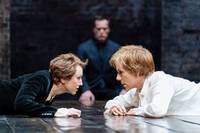
CurtainUp
The Internet Theater Magazine of Reviews, Features,
Annotated Listings
A CurtainUp London Review
Mary Stuart
|
"The condition of monarchy is captivity".
— Elizabeth
|
 v v
Lia Williams, John Light and Juliet Stevenson (Photo: Manuel Harlan)
|
The toss of the coin takes place at each performance with Williams and Stevenson accepting whatever the toss of the coin determines. The year 1587 is important. England has been in a state of flux since the Protestant Reformation brought about by Henry VIII's desire to divorce his Catholic supported wife Catherine of Aragon in order to produce a son. The Tudors have come to the throne of England in 1485 under Henry VII and were cursed by Elizabeth Woodville, queen to Edward IV and mother to the Princes in the Tower. The curse was that their line would die out and Elizabeth I is the last of the Tudors, a Virgin Queen and at 53, long past childbearing age.
The religion of the country as explained in Schiller's play has changed from Catholic to Protestant and back to Catholicism under Mary Tudor, Catherine of Aragon's daughter and, on her death, back to Protestantism under Elizabeth. Each change brings persecution for ministers and supporters of the other religion and instability for the country.
In 1587 England is poised for the invasion of Spain; Spanish Catholicism and the Inquisition in the shape of the Spanish Armada of 1588. The obvious Catholic candidate to rule England after the death of Elizabeth is her cousin, Mary Stuart and in Catholic eyes, the rightful heir to Mary Tudor as neither Edward VI who died as a child nor Elizabeth are accepted as legitimate children of the king by Catholics. Mary's claim is through her grandmother King Henry VIII's sister Margaret who married the Scottish king.
Schiller's play has been adapted by the director Robert Icke. I have never seen the original so I cannot comment on the closeness or otherwise of the adaptation. What the production may have lost in historical credibility, it has gained in clarity. I mean that I was never convinced that we were watching two queens from the 1500s but instead a portrait of two women for whom the crown is an imprisonment. As Elizabeth says, "The condition of monarchy is captivity". Schiller's theme is the similarities between the two women and the contradictions implicit in their characters.
The performances of Lia Williams as the ill-used Mary and Juliet Stevenson as the irritable red haired queen are compelling but neither places us in the sixteenth century. There are several other liberties taken with historical information in this play like the rumoured affection with which Elizabeth's favourite, the Earl of Leicester (John Light) holds the beautiful Mary, Queen of Scots (one way of solving the Mary problem had been to marry her to an English nobleman but Leicester declined) or the meeting between the queens which definitely did not take place.
Schiller obviously was more sympathetic to the romantic figure of the Scottish queen than he was to Elizabeth. The closing scene which sees Elizabeth imprisoned in a robe held up by a red taped French farthingale and her face crudely painted by one of the male courtiers, caked with white and all topped with the red wig, while Mary is led to the scaffold underlines this. Up to now the women have worn silk shirts and velvet trouser suits. Mary may have lost her head but Elizabeth now has Mary's death on her conscience even though she tries to blame her secretary for carrying out the order.
The slant in favour of Mary unbalances the Greek aspects of this tragedy, which should be the stability of the English nation against civil war as opposed to the rights of an individual, the queen to be tried by her peers and to hear, with a right of reply, the evidence against her.
There are interesting supporting performances: Elliot Levey as the scheming Burleigh, Elizabeth's spymaster. When Mary debates with Burleigh, the director has placed her face close to his face in a challenging invasion of his personal space. John Light plays Leicester the courtier who supposedly has to choose between the queens, Rudi Dharmalingam is Mortimer the double agent, Christopher Colquhoun is Paulet, in charge initially of Mary's captivity at Fotheringay and Michael Byrne as elder statesman Talbot. Carmen Munroe is Kennedy, Mary's attendant who counsels on Mary's ill judged falling for her third husband the Earl of Bothwell and her condonement of the murder of her second husband, the Earl of Darnley, "Falling in love is a madness. There's no cure but time."
The famous meeting between the queens ends in cat fight before the interval. Hildegarde Beckler's set is simple rounded brick walls with curved glass and brass seats and the circular set allows Elizabeth to circle the stage, pacing like a maelstrom as she argues with Leicester.
The production is well worth seeing even if the whole doesn't quite live up to the excitement of the opening scene.
What I don't think Schiller's play tells us is that it is Mary's protestant son James VI of Scotland becomes the first Stuart monarch, James I of England, as the chosen successor of Queen Elizabeth and, that just over a hundred years later the Stuart line too, like the Tudor line will die out after one Stuart king has been beheaded after a civil war and another deposed to France for Catholic tendencies.
Search CurtainUp in the box below
PRODUCTION NOTES
Mary Stuart
Written by Friedrich Schiller
Adapted and directed by Robert Icke
Starring: Juliet Stevenson, Lia Williams, Michael Byrne, Christopher Colquhoun, Rudi Dharmalingam, Elliot Levey, John Light, Carmen Munroe
With: Calum Finlay, David Jonsson Fray, Elieen Nicholas, Daniel Rabin, Harry anton, Matt Butcher, Jane MacFarlane, Denise Stephenson, Hannah Ankrah, Valerie Antwi, Sarah Balfour, Lisa Chiu, Kristine Kruse, Nazarene Williams
Design: Hildegard Bechtler
Lighting Design: Jackie Shemesh
Sound Design: Paul Arditti
Composition: Laura Marling
Running time: Three hours with an interval
Box Office: 0844 871 7627
Booking at the Duke of York's to 31st March 2018 then,
Theatre Royal Bath from Wednesday 4th – Saturday 14 April,
Salford Lowry from Tuesday 17th – Saturday 21st April and
Cambridge Arts Theatre from Monday 23rd – Saturday 28th April 2018
Originally staged at the Almeida Theatre in December 2016
Reviewed by Lizzie Loveridge based on 29th January 2018 performance at the Duke of York's, St Martin's Lane, London WC2N 4BG (Tube: Leicester Square/Charing Cross)
Index of reviewed shows still running
REVIEW FEEDBACK
Highlight one of the responses below and click "copy" or"CTRL+C"
- I agree with the review of Mary Stuart
- I disagree with the review of Mary Stuart
- The review made me eager to see Mary Stuart
Paste the highlighted text into the subject line (CTRL+ V):
Feel free to add detailed comments in the body of the email. . .also the names and emails of any friends to whom you'd like us to forward a copy of this review.
For a feed to reviews and features as they are posted at http://curtainupnewlinks.blogspot.com; to your reader
Curtainup at Facebook . . . Curtainup at Twitter